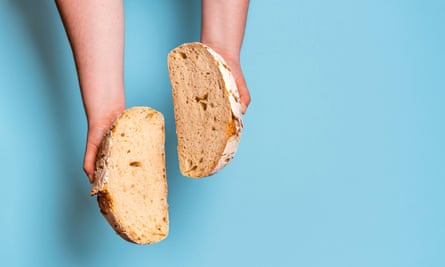One gray Sunday in the middle of the Covid lockdown, I received an unwelcome call from my family doctor. Until then, for virtually my entire life, I had managed to stay out of a doctor’s office, except for routine checkups. My luck had run out.
“I am sorry to disturb you on a weekend,” she said. “But your tests just came back and your blood sugar levels are alarming. I am pretty sure you have diabetes.”
During the lockdown, I experienced symptoms I now understand to be warning signs for type 2 diabetes, the disease – along with its precursor pre-diabetes – that, according to the US Centers for Disease Control and Prevention, afflicts nearly half of all adult Americans. I was always thirsty, and had taken to drinking pitchers of sweet apple cider. I was urinating more than usual, and my urine had an orange hue. When my doctor gave me a blood test, she found my A1C, a measurement of blood sugar over a three-month period, was 11.8%, a level commonly known as “through the roof”. Anything over 5.7% is considered pre-diabetic. Above, 6.4%, you’re diabetic.
I did my homework. I learned that type 2 diabetes is a condition of high blood sugar that makes me vulnerable to blindness, amputation and kidney and heart disease. I am not a worrier by nature, but I suddenly had the dreaded sensation that my life was about to be shortened. In reality, my education about the dysfunctional state of American diet and nutrition was just beginning.
This was a new world for me, but it was also eerily familiar. For the past several years, as founder of a non-profit criminal justice organization called the Marshall Project, I have focused on the issue of criminal justice reform. I learned that as polarizing as criminal justice and racial equity are in this country, nutrition is even more controversial. If mass incarceration is a national scandal hiding in plain sight, then our twin diabetes and obesity epidemics – which disproportionately afflict the poor and people of color – are similarly sources of deep human suffering that we have simply become inured to.
The Upper East Side diabetes specialist my doctor sent me to tried to put me at ease. “This is not a death sentence,” he said. “It tends to get worse over time, but with the right medication and lifestyle changes, it can be managed.” He wrote prescriptions for insulin and metformin, and offered meticulous instructions on how to prick my fingertip to measure my blood twice daily, how to record my numbers, and how to stick a needle into my belly to inject insulin.
I asked him what, if any, changes I should make to my diet. Two decades earlier, I had been affected by the writer Gary Taubes’s controversial and groundbreaking 2002 article in the New York Times Magazine, “What If It’s All Been a Big Fat Lie?”, which chronicled the growing movement in dietary and diabetes circles to reduce carbohydrates in order to lose weight and lower blood sugar.
Taubes’s forthcoming book, Rethinking Diabetes: What Science Reveals About Diet, Insulin and Successful Treatments, explores a century’s worth of research into diabetes, and attempts to show why so many experts got things so wrong for so long. This is Taubes’s fifth book about nutrition science, and I would argue that his meticulous, science-based work (he is a three-time winner of the National Association of Science Writers’ Science in Society Journalism award) makes him the Bryan Stevenson of nutrition, an early voice in the wilderness for an unorthodox view that is increasingly becoming accepted.
While low-carbohydrate diets might be more accepted today than when Taubes first wrote about them in 2002, in large part because of his journalism and advocacy, they are still far from the standard of care for patients, even for diabetics. In fact, my doctor’s facial expression suggested that this might be the very first time he had considered the question of how diet might factor into diabetes treatment.
“Sure, you should cut down on sugar if you can,” he said meekly. “Basically, if you’re at a birthday party, instead of eating a piece of cake, just have half a piece.” Was this the equivalent of a doctor telling a smoker with lung cancer to smoke fewer cigarettes instead of quitting? Pharmaceutical intervention was clearly going to be the prescribed medicine. Dietary change was hinted at, but not stressed.
On my way out, the doctor next handed me a brochure, Living with Diabetes, published by the American College of Physicians. On its cover was a photo of a cheerful and very overweight couple holding hands. “You can still eat carbs,” it read. “Just make the portion sizes smaller.” Inside were photos of delicious carbohydrate-rich foods such as cake, orange juice, bagels and pasta, followed by pages of instructions on preparing, injecting, storing and traveling with an insulin supply.
“At first, I didn’t want to take shots, but I didn’t realize how much better I could feel,” cooed one happy customer in the brochure. “It made a big difference to me.”
On page 57, in fine print, came the kicker: “The development of the Living with Diabetes: An Everyday Guide for You and Your Family was funded by a grant from Novo Nordisk,” the Danish pharmaceutical giant that has been selling insulin to diabetics since 1924.

Fear can be a powerful motivator, and I happen to have an aversion both to shooting substances into my body and premature death, so I decided to read the literature about what type 2 diabetes is. I discovered a gigantic community of scientists, doctors and patients who had already come to understand that type 2 diabetes is in fact reversible – meaning, blood sugar levels can be reduced below the diabetes range, although this does not guarantee the diabetes has gone permanently – and that the remedy is straightforward: stop eating carbohydrates, the one macronutrient that diabetics like me cannot safely metabolize without the help of drug therapies.
I stopped eating the breads, pastas, sweets and starches I had grown accustomed to. It wasn’t easy; I still miss my pizza and bagels and sushi (white rice is a no-no for me). I had consumed all of it with gusto in the old days.
In effect, I was living in parallel universes. On one hand, I was in close consultation with my doctor, who prescribed cumbersome, painful and expensive drug therapies that were consecrated by the American Diabetes Association. Independently, I was pursuing a cheap, commonsense path that was working better than any drug could. Happily, my blood sugar numbers plummeted. My A1C fell to 5.4%, a healthy level. Within three months of first shooting insulin into my belly, my diabetes appeared to be in remission. I lost 20lb. One way to think about it is that my diabetes manifested itself if I ate carbs. If I didn’t, I was essentially fine.
To his credit, when my doctor saw my blood sugar numbers, he took me off all medication. “You don’t need me any more,” he said. But he also evinced a shocking lack of curiosity about what I did to lower my A1C so dramatically. I now realize my doctor was making an honest attempt to follow the guidelines issued by the American Diabetes Association. I didn’t ask him if he was aware that the top five funders of the ADA are the pharmaceutical companies Abbott, AstraZeneca, Eli Lilly and Co, Novo Nordisk and Regeneron.
Nutrition in America is undoubtedly tricky. Consider the debates medical professionals still engage in – low fat v low carb, carnivores v vegetarians and vegans, the energy balance model (calories in, calories out) v the carbohydrate insulin model (it’s the carbs!). Given the billions spent on research there is a shocking lack of consensus about why we get fat and diabetic, and what we should eat and not eat to avoid it or prevent it.
There is more to this than one patient’s anecdotal story. Diabetes and obesity are costly killers. Diabetes alone is likely to be the sixth-highest cause of death for Americans this year, but since it is also closely linked to coronary and kidney diseases, Alzheimer’s and stroke, it is difficult to know precisely how many Americans die prematurely because of it.
Diabetes is also big business – in 2017, Americans spent $237bn treating the disease, approximately $100bn more than a decade earlier. Obesity – which is either a symptom or a cause of diabetes, depending which medical professional you ask – accounts for billions more dollars. Nearly half a million Americans’ deaths annually can be attributed to excess weight, according to a 2022 article in the Lancet.
I recently asked Gary Taubes how we might create the same sense of national urgency about diet and diabetes that the Marshall Project and other organizations are trying to bring to criminal justice policy. His reply was both measured and responsible. He did not call for immediately banning or taxing sugary substances, toxic as he might think they are, as I might, nor did he demonize the pharmaceutical or food industries or the medical profession, as I would.
“There is significant evidence that replacing carbohydrates with mostly fats is beneficial in treating both obesity and diabetes,” he said. “There have been close to 200 clinical trials that have been done to test health outcomes of these diets.” But, he added, none of those trials were on a scale or duration that provide the kind of evidence needed to move the medical consensus.
What was needed, he said, were massive government-funded nutritional studies that establish once and for all why we get fat, and how we should treat people with diabetes. “I believe the scientific consensus is wrong, but we need more studies to prove it,” he concluded.
This was not the answer I was looking for, but I respected Taubes’s respect for dietary due process. Taubes is a journalist who thinks like a scientist – this is what makes his work so compelling.
I do not think like a scientist; I am a patient. It outrages me that we allow companies to market sugary cereals to children, and sugary beverages to everyone else, or that the American Diabetes Association simultaneously is funded by the pharmaceutical industry and tilts so heavily toward pharmaceutical solutions for my disease. Or that more than 100,000 people will die this year from diabetes, a disease that is often reversible.
It astounds me that there is still such resistance to funding nutritional studies that get to the bottom of whether sugar is addictive or toxic or determine once and for all why 42% of all Americans, according to a recent CDC study, are obese. Finally, it pains me that overweight people are demonized, despite mountains of evidence suggesting obesity is a function of metabolism, poverty, poor diet and bad medical advice.
The obesity and diabetes epidemics are a collective national failure; the sooner we acknowledge this, the sooner we can begin work on fixing them.
This article was amended on 6 December 2023 to state that while type 2 diabetes can be put into remission – or “reversed” – by lifestyle changes, there is no guarantee that this is permanent.
-
Neil Barsky is a former Wall Street Journal reporter and founder of the Marshall Project, a non-profit newsroom that covers the US criminal justice system
